Greetings, fellow drone aficionados; since I first penned this article a few years back, the landscape of sub-250g drones has evolved dramatically. These lightweight flying marvels have soared to new heights in popularity and innovation, with an ever-expanding array of options available. After immersing myself in extensive research and personally experiencing the thrill of piloting some of these compact wonders, I’m delighted to present an updated version of my article showcasing the best drones under 250g for 2023. Buckle up and prepare to be amazed!
Why Should You Buy A Drone Under 250g?
Drones under 250g are very popular among casual flyers, drone enthusiasts and even professionals. There are many reasons why drones in the sub-250g category are popular. Some these reasons include the following:
- Regulatory benefits: In many countries, drones weighing more than 250 grams are subject to stricter regulations and registration requirements. By choosing a drone under this weight limit, users can avoid the hassle of registration and additional paperwork while still enjoying the benefits of drone ownership.
- Portability: Smaller, lighter drones are much easier to carry around, making them ideal for travellers, adventure enthusiasts, and content creators constantly on the move. Their small, foldable compact design allows for easy storage in backpacks or camera bags without adding significant bulk or weight.
- Ease of use: Drones under 250 grams are often designed with beginners in mind, providing user-friendly features and intuitive controls. This makes them a perfect choice for those new to the world of drones or for casual users who want to capture stunning aerial footage without a steep learning curve.
- Safety: Lightweight drones pose less of a risk, as their reduced mass and smaller size will reduce the risk of any serious injury or damage. This makes them a more attractive option for beginners.
- Affordability: Drones under 250 grams are generally more budget-friendly than their heavier counterparts. Their lower price point makes them accessible to a wider range of users, from hobbyists to professionals looking for a secondary drone for specific tasks.
- Noise reduction: Smaller, lighter drones typically produce less noise during operation, making them less intrusive and more suitable for use in areas where noise pollution is a concern.
With these advantages, it’s no wonder that drones under 250 grams have become increasingly popular among drone enthusiasts and professionals alike, offering a perfect balance of portability, ease of use, and regulatory flexibility.
Are These Drones Under 250g Suitable For Beginners?
Yes, all the drones on this list are easy to operate and are suitable for beginners, however, if you are a beginner, I would advise you to look at cheaper drones than the ones on this list.
The drone on this list are quite expensive, with the cheapest selling for around $300, they are entry-level drones for photography, so if you are looking for a cheap drone to have some fun with, check out my list for the best drones for beginners. My personal favourite is the Tello drone, it weighs less than 250g, is suitable for beginners and kids and is fun to operate.
8 Best Drones Under 250g
1. DJI Mini 3 Pro
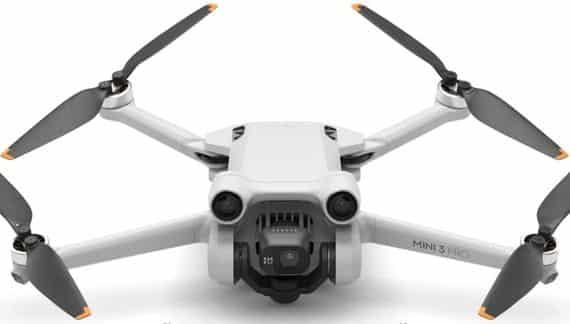
This incredible little drone is perfect for aerial photography and videography, and trust us, it’s going to blow your mind with its amazing features and performance, all packed in a tiny package!
Despite its small size, the DJI Mini 3 Pro doesn’t compromise on functionality. It comes equipped with a 3-way obstacle avoidance safety system, long flight time, 4K HDR video recording, and intelligent flight modes. This makes it stand out as the number one choice in our list of the best drones under 250 grams.
The camera on this little marvel is top-notch. It boasts a 1/1.3-inch sensor and bigger 2.4μm pixels, ensuring your aerial photos will be absolutely stunning. With D-Cinelike Colour mode and HDR recording, you’ll have a world of creative possibilities at your fingertips. The Intelligent Flight Battery is another fantastic feature, providing up to 34 minutes of flight time – and you can extend this with the intelligent plus battery that provides 47 minutes of flight time.
Worried about flying this tiny powerhouse? Don’t be! The DJI Mini 3 Pro is incredibly user-friendly, with responsive controls, smart features like APAS 4.0 that detect objects in real-time, and MasterShots for executing pro-level manoeuvres to create cinematic videos. The DJI O3 video transmission system ensures you’ll have a clear 1080p/30fps live feed from up to 12 km away.
The DJI Mini 3 Pro is our number-one choice for the best drones under 250 grams, and for good reason. It’s suitable for beginners but is geared towards those with more experience and who want a drone for professional photography. Check out the video below for some stunning DJI Mini 3 Pro footage.
Key Features
- 1/1.3-inch CMOS sensor
- 48MP images
- Panorama and AEB photography modes
- Records videos in 4k at 60fps, 2.7k at 60fps & 1080p at 60fps
- HDR videos & images
- Intelligent video recording with Quickshots & Mastershots
- 3-way obstacle avoidance system
- Autonomous flight modes
- 34 minutes of flight time
- 12km transmission range
- Large image sensor for a sub-250g drone
- Good camera performance in low-light conditions
- The d-Cinelike colour profile for HDR videos
- DJI O3 for long-range video transmission
- Active Track, POI and Spotlight autonomous flight modes
- Mastershots and Quickshots for one-tap cinematic videos
- Geared towards professionals.
- It's an expensive drone
2. DJI Mini 3
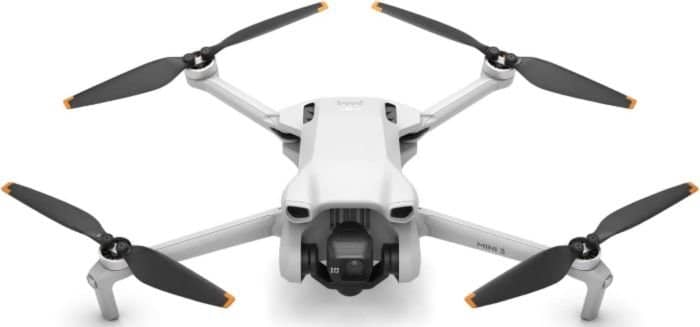
The DJI Mini 3 comes in at number two. This compact and foldable camera drone is perfect for those who crave adventure and ease of use. The design makes it incredibly convenient to take with you wherever your journey leads.
The camera on the DJI Mini 3 is just as impressive as the Mini 3 Pro, featuring the same 1/1.3-inch CMOS sensor that can capture 48MP images and 4K videos. The camera has multiple photography modes like panorama, AEB and HDR and has a good zoom function.
The Mini 3 also comes with some cool, intelligent features, such as QuickShots, allowing you to record cinematic videos from different angles with the push of a button.
Other features of the DJI Mini 3 include decent wind resistance ( level 5), a 10km video transmission range thanks to the DJI O2 transmission technology, and an automatic return-to-home function.
The DJI Mini 3 Pro and Mini 3 are similar, but there are some significant differences, and they are:
- The Mini 3 has a longer flight time of 38 minutes.
- There is no obstacle avoidance system with the Mini 3.
- The Mini 3 lacks autonomous flight modes like Active Track, POI, and Waypoint.
Despite these differences, the DJI Mini 3 remains a solid choice for those seeking a compact and powerful drone with an impressive camera.
Key Features
- 1/1.3-inch sensor with f/1.7 aperture and 82.1°
- 48MP still images
- Records 4K videos at 30fps, 2.7k at 60fps
- AEB, Panorama and HDR photography modes
- Quickshots
- Automatic return to home
- 38 minutes of flight time
- 10km video transmission range
- Longest flight time for a sub-250g drone
- Stunning camera captures amazing videos and photos
- HDR Video and images
- Long transmission range
- Cheaper than the Mini 3 Pro
- No obstacle avoidance
- No autonomous flight modes
3. Autel Nano Plus
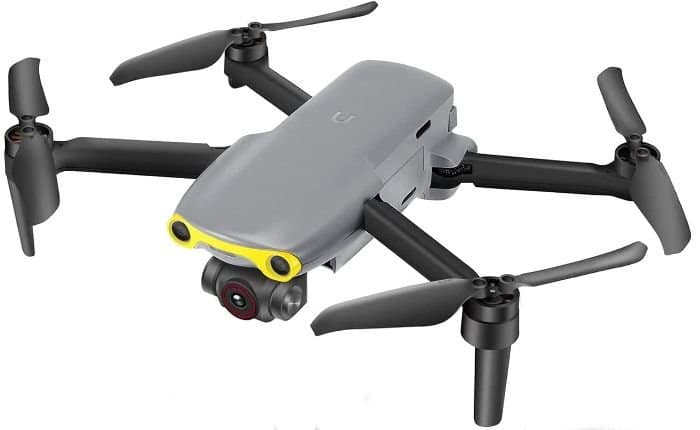
The EVO Nano Plus drone is a compact, lightweight aerial device that comes with a 1/1.28-inch CMOS sensor, capable of capturing breathtaking 50 MP photos. Its RYYB colour filter array design and sizable f/1.9 aperture ensure that your images will be vibrant and full of detail. In addition, the drone features a PDAF+CDAF autofocus system, which allows users to track fast-moving subjects with precision.
To guarantee smooth, ultra-sharp 4K at 30fps video recording, the Nano Plus drone is equipped with a three-axis mechanical gimbal that counteracts vibrations.
The Autel Nano Plus comes with several intelligent features such as Dynamic Track 2.1, SkyPortrait 3-way obstacle avoidance system and Quickshots.
While the Nano Plus drone has obstacle-avoidance technology, it’s important to note that its system is not as advanced as the one found in the
DJI Mini 3 Pro. The Nano Plus drone has a flight time of up to 28 minutes, which is slightly less than the 30-minute or better flight times offered by the DJI Mini drones.
Despite these differences, the EVO Nano Plus drone remains an excellent option for those seeking a small yet powerful drone for capturing stunning aerial footage.
Key Features
- 1/1.28- inch CMOS sensor with RYYB filter
- 50MP still images (RAW & JPEG)
- Records videos in 4K@30FPS, 2.7K@60FPS
- HDR Images & Videos
- 16× Digital Zoom
- Intelligent flight modes
- Obstacle avoidance system
- 4 Quick Shots
- 10km Range
- 28 Minutes Of Flight Time
- Powerful camera with a large image sensor with RYYB filter
- Fantastic low-light camera performance
- Autofocus technology
- Intelligent features such as Dynamic Track and SkyPortrait
- Autel SkyApp is user-friendly and comes with some cool features
- Long video transmission range
- Flight time could be better
- Limited obstacle avoidance system
4. DJI Mini 2
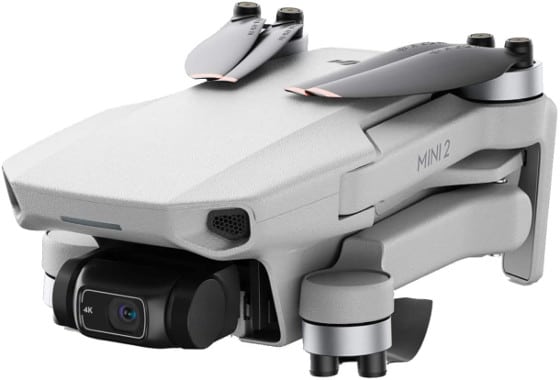
The Mini 2 remains one of my favourite drones and is one of the most popular sub-250g drones on the market.
The DJI Mini 2 is a great drone known for its foldable design, which allows for easy transport and storage. It features OcuSync 2.0 transmission technology, ensuring stable and long-range video transmission, while GPS and downward-facing sensors provide precise hovering and stable flight. The Mini 2 can withstand wind resistance up to level 5 on the Beaufort scale and offers intelligent flight modes such as QuickShots, Panorama, and Timed Shots.
In terms of camera quality and performance, the Mini 2 is equipped with a 1/2.3-inch CMOS sensor, 12MP photo resolution, and 4K/30fps video resolution. The 3-axis gimbal ensures stabilised footage, and the drone also offers 4x zoom (2x lossless) in 1080p resolution.
As for flight time and range, the DJI Mini 2 boasts a maximum flight time of up to 31 minutes and a maximum video transmission range of up to 10 km with OcuSync 2.0
Overall, this is the best low-cost 4k camera drone currently on the market and is suitable for professional drone photography.
Key Features
- 1/2.3- inch CMOS sensor
- 12MP still images (RAW & JPEG)
- Records 4K videos at 30FPS, 2.7K at60FPS
- Auto Exposure Bracketing For HDR Images
- 4X Digital Zoom
- 5 Quick Shots
- OcuSync 2.0 Transmission Technology
- 10km Range
- 30 Minutes Of Flight Time
- Long flight time
- Long transmission range
- Fantastic live video feed
- Allows users to capture short videos with the Quickshot feature.
- Decent wind resistance
- Compatible with third-party apps like Litchi and Drone Link
- No Active Track, orbit or waypoint flight modes
- No obstacle avoidance
5. DJI Mini 2 SE
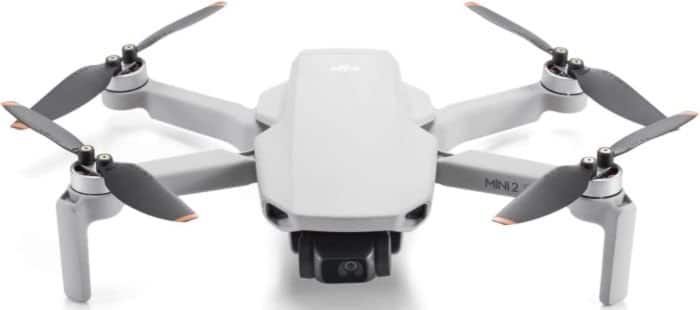
The DJI Mini 2 SE is a lightweight, compact, and foldable drone designed for beginners and hobbyists. It weighs under 249 grams and features a 2.7K video camera for capturing high-quality aerial footage. The drone offers a 10km video transmission range and a flight time of 31 minutes. It includes a Return to Home function for added safety and ease of use.
The DJI Mini 2 SE comes with several intelligent flight modes, such as QuickShots, which allows users to capture professional-looking footage with just a few taps. The drone can withstand level 5 wind resistance, ensuring stable flight and reliable content capture in various conditions.
The drone’s 3-axis mechanical stabilisation system, along with its 1/2.3-inch CMOS camera, allows users to capture high-quality 12MP photos and up to 2.7K videos. The added advantage of 4x zoom enhances the versatility of the camera, allowing users to capture distant subjects with ease.
The are a couple of differences between the Mini 2 SE and Mini SE one is the video transmission range; the Mini 2 SE uses Ocusyn 2.0 for a longer transmission range, and the other is that the Mini 2 SE can capture RAW images, which provide photographers will more control in post-processing.
Key Features
- 1/2.3-inch CMOS sensor
- 12MP images (RAW & JPEG)
- Records videos in 2.7k at 30fps
- 4x digital zoom
- 5 Quickshots
- 3-axis gimbal
- 31 minutes of flight time
- 10km video transmission range
- Long flight time
- Long transmission range
- Fantastic live video feed
- Allows users to capture short videos with the Quickshot feature.
- Decent wind resistance
- No Active Track, orbit or waypoint flight modes
- No obstacle avoidance
- Currently not compatible with any third-party flight apps
6. DJI Mini SE
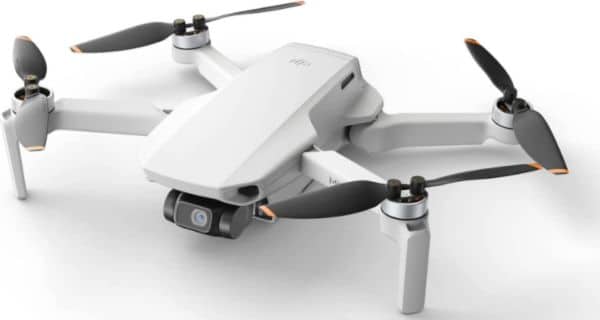
The DJI Mini SE is an affordable, compact, and lightweight drone that offers users a great introduction to the world of aerial photography and videography. It is designed with ease of use and portability in mind, making it an excellent choice for beginners and enthusiasts alike.
The Mini SE features a 1/2.3-inch CMOS sensor that is capable of capturing 12 MP still images and 2.7K Quad HD video at 30fps. This ensures high-quality, detailed photos and videos for users looking to document their adventures or explore creative perspectives.
With a three-axis gimbal, the DJI Mini SE provides smooth, stable footage, reducing unwanted camera shake and delivering professional-looking results. The drone has a long flight time of 30 minutes, allowing users to enjoy extended periods of flight and capture more content in a single session.
Some of the intelligent flight modes include QuickShots, such as Dronie, Circle, Helix, and Rocket, which help create dynamic shots with just a few taps.
While the DJI Mini SE does not have the advanced features found in the Mini 3 and Mini 3 Pro, it is still an excellent entry-level drone for photography. Read my full review of the DJI Mini SE
Key Features
- 1/2.3-inch sensor
- 12MP images
- Records videos in 2.7k at 30fps
- 3-axis gimbal
- 5 Quickshots
- Automatic return to home
- 30 minutes of flight time
- 4km transmission range
- Excellent entry-level drone for photography
- The 2.7k videos are very good quality
- 3-axis gimbal for image and video stabilisation
- One of the cheapest GPS drones from DJI
- Easy to operate
- No follow-me mode
- No obstacle avoidance
7. DJI Mavic Mini
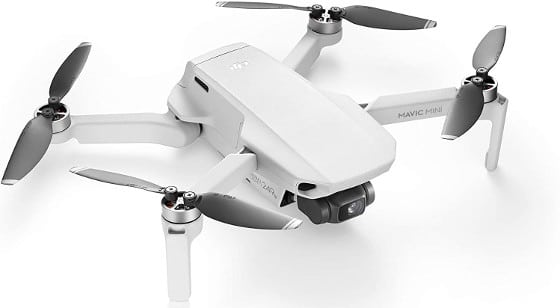
It’s been a few years since the Mavic Mini was released, and although DJI has stopped production of the drone, it remains popular with drone enthusiasts. You can still find new or refurbished Mavic Mini drones on Amazon and eBay; it was the first drone from DJI in the sub-250g category, and at the time, the design and specs were quite ground-breaking.
The drone has similar features to the Mini SE; it has an HD camera that can record 2.7k videos at 30fps and captures images in 12MP. The camera is stabilised by a 3-axis gimbal for smooth and distortion-free images and videos.
The Mavic Mini has 4 Quickshots that allow users to capture short HD videos that are perfect for sharing on social media. It also comes with an automatic return-to-home function that is activated whenever the battery gets low or the connection between the drone and controller is lost for a few seconds.
Key Features
- 1/2.3-inch CMOS sensor
- 12MP still images (JPEG)
- Records videos in 2.7K at 30fps,1080p at 60fps
- 720p Live video feed
- Enhanced WiFi Transmission Technology
- 4km Range
- 30-minute Of Flight Time
- 4 Quick Shots
- Very good camera quality
- Captures crisp still images
- 3-axis gimbal
- Stable flight in mildly windy conditions
- One of the shortest video transmission range for a DJI drone
- No intelligent flight modes
- No obstacle avoidance sensors
8. Potensic Atom SE
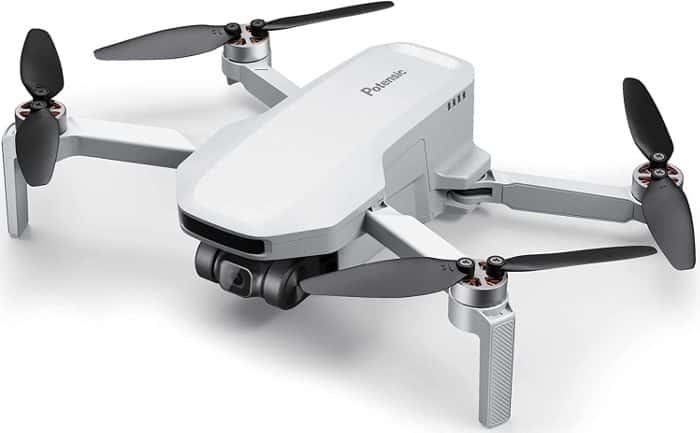
The Potensic Atom SE drone is a lightweight and foldable drone that features a 4K EIS camera with ShakeVanish technology. The drone has a weight of less than 249g and can fly for up to 31 minutes. Its camera is equipped with a 1/3″ CMOS sensor and is capable of shooting 12MP photos and 4K@30fps or 2.7K@60fps HD videos. The ShakeVanish technology in the camera helps to reduce camera shake and vibrations caused by the movement of the drone during flight, resulting in smoother and more stable images with less blurring and distortion. The camera has a 118° field of view and a vertical range of +20° to -90°. The Potensic Atom SE drone is also equipped with a SurgeFly flight control system, which provides beginner, normal, and sport modes and allows for a flexible and easy flight control experience. The drone can reach a maximum speed of 16m/s and has a 4KM FPV transmission range. It also features an auto-return function and is easy to control for all skill levels.
Key Features
- 1/1.3-inch Sony image sensor
- 12MP images
- Records video footage in 4k at 30fps
- Electronic image stabilisation
- Follow me, orbit and waypoint intelligent flight modes
- 31 minutes of flight time
- 4km video transmission range
- HD 4K camera captures amazing videos and photos
- ShakeVanish image stabilisation
- Cheapest 4K camera drone
- Long flight time
- Good video transmission range
- No 3-axis gimbal
No obstacle avoidance
Not stable in windy conditions
What is the best DJI Drone Under 250 grams?
As you will have noticed, this list is dominated by DJI; this is because when the rules for sub-250g drones were set in 2015 by the FAA, DJI made a commitment to manufacturing more drones in this category as drones under this weight were deemed safer and did not require registration. The best DJI drone in the sub-250g category is the DJI Mini 3 Pro.
Rules For Drones Under 250 Grams
In the United States, the FAA has established specific regulations for drones weighing less than 250g. These lightweight drones are exempt from registration requirements and have fewer restrictions when it comes to flying for recreational purposes. If you are a beginner, you will need to pass the FAA TRUST exam; this is a new test developed by the FAA specifically for recreational pilots and is free to take online However, if you plan on flying for commercial reasons, you will need to obtain the Part 107 certificate and register the drone.
In the UK, the CAA requires anyone who flies a drone that has a camera to obtain a Flyer and Operator ID. As all the drones on this list meet this criteria, you will need to get these IDs if you live in the UK.
Drone regulations vary significantly from country to country. When travelling abroad with your drone, it is essential to research the specific rules and requirements of your destination to avoid fines or confiscation of your equipment. Some countries may require registration, while others may have strict no-fly zones or limitations on drone usage.
Final Thoughts
In this blog post, we have explored the best drones under 250g, highlighting their features, advantages, and disadvantages. These lightweight drones offer a range of capabilities, making them suitable for various users, from beginners to experienced pilots. By considering factors such as flight time, camera quality, range, stability, price, and safety features, you can make an informed decision on the best drone in this weight category for your needs.
FAQs
Do you need to register a drone under 250g?
In the United States, according to the FAA regulations, drones weighing less 250 grams do not need to be registered, and operators do not need a license to fly them for recreational purposes. However, if you plan to use your drone for commercial purposes, you will need to obtain a Part 107 Remote Pilot Certificate, regardless of the drone’s weight.
In the UK, you will need to obtain a Flyer and Operator ID from the CAA, the Flyer ID will require you to pass an online test that consists of 40 multiple-choice questions. It’s easy to pass as you are allowed to reference the Drone Code (the official guide for drone pilots in the UK) while taking the test.
Can you fly drones under 250 grams anywhere?
No, the rules for where you can operate drones apply to all drones, including drones under 250g. So, you must follow the rules and regulations of your local aviation authority.
Is remote ID required for drones under 250 grams?
If you have a drone that weighs under 250g and only fly it for recreational purposes, remote ID for this drone is not required because it does not need to be registered. However, if you use it for commercial purposes or make money with it some other way, you will need to register the drone, and it will require a remote ID.

